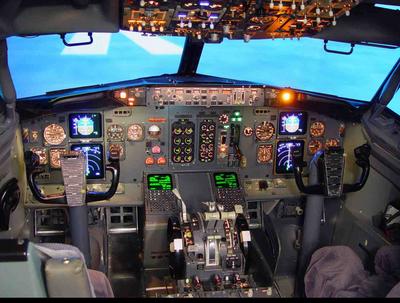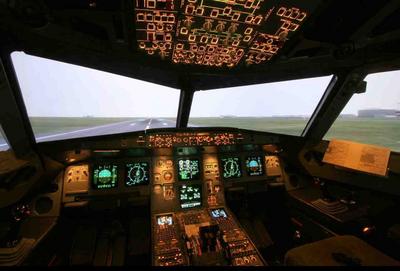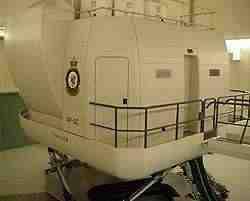
My assignment today was to provide "simulator support," to act as a regular pilot for other crewmembers who were being trained in an aircraft simulator. I occupy my regular pilot seat in the simulator, and we all do our regular jobs while we are put thru a series of (thankfully irregular) scenarios--failures and fires and windshear and severe thunderstorms and other assorted & sundry abnormalities, all the fun stuff the nervous passenger envisions while they should be sleeping the night before they fly.
This is one of those oddities about the airline industry, something tightly woven into the fabric of my working life but which probably has few analogs in other industries. I always think of this when I see a train pulling its load cross-country; everyone knows what a train is and generally how it operates, but nobody except an industry insider would have a clue about the huge number of strange job descriptions involved in getting that television set from a port in Seattle to a Pamida store in rural Missouri. There are a few visible, well-known jobs that represent a whole industry to people (like airline pilot). But this is always a tip-of-the-iceberg illusion.
Anyway. Everyone's job involves some degree of specializing in tasks the rest of the world is not privy to. This is hardly the place to detail in a single lump all the minutiae of airline life (it would make an excruciating read for most people anyway), but I think one aspect of all this is of some interest to many of us who fiddle with computers: the airplane simulator.
I've been trained in simulators for four of the five big airplanes in which I've made my living over the past decade, and I always emerge from these sessions gushing about the magic of simulation (and smarting from the emotional bruises inflicted therein).
A professional airline simulator is the ultimate in virtual reality, the result of a focused commitment to fool the human mind that hard-core gamers can only dream about. These are technological marvels costing many millions of dollars and requiring a small army of technicians to keep them operating smoothly (our sims, one or more for each airplane type in the fleet, are generally in use 20 hours of the day, so downtime is really not an option). The simulator, from the inside, is indistinguishable from the actual airplane cockpit--indeed, it's not an aesthetic mock-up, but actually constructed from the aircraft parts catalog; at least for the visible parts, if something breaks it gets fixed off the same shelves as the actual airplanes.

It's what's behind the visible panels that diverges sharply from the real airplane. And that's the magic. It's like Yul Brynner in "Westworld," where the skin is peeled away to reveal *gasp* a machine underneath. In the case of the DC-8, the simulator makes the airplane look like a haywagon: the computer technology needed to simulate flight requires many times the sophistication of the technology needed to construct the actual airplane! (Of course the real airplane does its own magic, carrying 355,000 lbs airborne.)
 Each simulator--each one is dedicated to a single make & model & series of airplane--is a several-ton box capable of holding 6-8 people which floats 10-15 feet off the ground on six huge hydraulic cylinders. The victims cross a gangway and enter a closed world, where the windows look onto computer-generated graphics that are just shy of photorealism. Viewed from the outside, the simulator while in use tilts and lurches, simulating to the occupants inside the accelerations and sensations of flight, down to the thump of expansion joints in the concrete as we taxi out for takeoff. The illusion of being in an actual airplane--the focus of all this engineering--is so carefully designed and evolved, and so absolutely convincing, that we emerge from extensive training essentially qualified to fly an airplane around at 600 mph without ever having set foot in the actual thing. Given the complication of the task in question, this is nothing short of amazing.
Each simulator--each one is dedicated to a single make & model & series of airplane--is a several-ton box capable of holding 6-8 people which floats 10-15 feet off the ground on six huge hydraulic cylinders. The victims cross a gangway and enter a closed world, where the windows look onto computer-generated graphics that are just shy of photorealism. Viewed from the outside, the simulator while in use tilts and lurches, simulating to the occupants inside the accelerations and sensations of flight, down to the thump of expansion joints in the concrete as we taxi out for takeoff. The illusion of being in an actual airplane--the focus of all this engineering--is so carefully designed and evolved, and so absolutely convincing, that we emerge from extensive training essentially qualified to fly an airplane around at 600 mph without ever having set foot in the actual thing. Given the complication of the task in question, this is nothing short of amazing.Simulators have come into such ubiquity in airline life for a couple reasons. First, it costs so damned much to operate an airplane on an hourly basis that an airline simply can't afford to get a pilot (let alone 5,000 of them) up to speed on all the shit he or she needs to know before they're turned loose by training in the actual airplane (though a couple tasks are still accomplished in the airplane proper). And second, there's a lot of stuff that we can experience in a simulator that simply cannot be duplicated in a real airplane (at least not without killing the very person you're trying to enrich with the hair-raising experience). One is virtually always flying around with an engine not operating, for example (less of a big deal on an airplane like the DC-8, which has four of them). But control failures and landing gear failures and blown tires and catastrophic failures of electrical or hydraulic systems are examples of things you simply could not do in a real airplane, but which have real value for crewmembers to see from the safety of a simulator.
Real value, maybe, but it often isn't fun (even if it's fascinating)! Since even the simulator is hugely expensive to buy and operate, you're virtually never allowed to just fly around without something being on fire or falling off or failing to operate properly. And the same computer advancement that makes this kind of simulation possible also makes for creatively bizarre and tortuous training routines for we poor crewmembers! You emerge from this training environment like a lab rat on a heated surface, ready in a twitching, overstimulated way, for any eventuality.
6 comments:
Wonderful post, by the way.
I was thinking of other industries that could benifit from such a simulation: Imagine if Parents had to go through 600 flight hours of parenting before they could conceive.
What about cab drivers?
In all actuality, nascar could use something liek this to save on the hundreds of wrecked practice cars. Maybe even save lives.
Parenting simulators! That's a fantastic idea! How about a conception simulator?
And I think it's part of the cabbie code to learn their trade on the hoof, as it were. That's where the "point system" came from!
Didn't they have one of those in "Everything You Always Wanted to Know About Sex"?
Great post--fascinating and who else would tell us? I hope you're not training any cabbie types in there.
That's right! The Orgasmatron, or something like that. I need to watch that movie again.
And no, we do not train cabbies. But we do train the occasional US Postal Service pilot...
I don't worry so much about cabbies but the crazed New Jersey drivers that invade New York and threaten the lives of iPod users, grandmas, baby strollers and my own little self.
It's like riding a motorcycle: no matter how much you try and do the right thing, you simply can't drive everyone else's car! Even trying to take public transit to avoid the hassles of driving only saves you the hassles of your driving!
Post a Comment